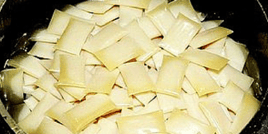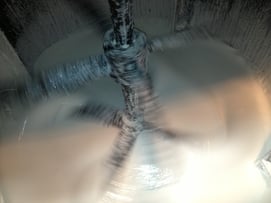If you want to get the most out of your glue, the temperature is a topic you should pay attention to. You'd be surprised how many application and equipment issues can be resolved by simply adjusting the temperature of your glue.
Today we'll cover our three major products' recommended glue operational temperature: gelatin glue, hot melt glue, and liquid water-based glue.
Gelatin Glue Temperature

Gelatin glue (protein, hide, or animal glue) is compostable and made from recycled materials. This glue is sold in jelly cakes, which are liquefied with heat and applied with equipment.
Gelatin glue works most efficiently at an operational temperature between 140°F and 150° F. Running the adhesive below this temperature could result in messy equipment and the bond setting a lot quicker than you want. If the glue runs above this temperature, the glue could burn, and the formula properties could be compromised.
After application, the glue is long-lasting and compostable in ideal conditions. For example, gelatin glue can be frozen up to -112°F, making it suitable for medical and food-grade packaging. Gelatin glue has been known to last for thousands of years if kept in the right conditions after application. To compost gelatin glue, it must be buried in a moist environment.
The recommended operating temperature of your protein glue can be found on the product's technical data sheet (TDS). Download our protein glue troubleshooting guide for solutions to everyday operational issues.
HOT MELT GLUE TEMPERATURE

Hot melt glues are polymer based and are 100% solids, containing no solvents or water. They are also thermoplastic, solid at room temperature, but liquefy upon heating. The lack of water and solvents allows hot melts to attain peak bonding strength quickly. The mechanical bonds they create penetrate the bonding surface before solidifying as they cool down.
The recommended temperature for most standard hot melt glues is 350°F. If the temperature is incorrect, you could experience pop opens, gelling, charring, smoking, or stringing issues. There are thousands of varying types of hot melt glues on the market, including low-temp and PUR hot melts.
Refer to the technical data sheet (TDS) for the recommended application temperature. Download our hot melt troubleshooting guide for solutions to common operational issues.
LIQUID WATER-BASED GLUE TEMPERATURE

Liquid water-based glues are generally eco-friendly and non-toxic. They are used in various applications and are commonly seen in case and carton sealing, packaging, woodworking, lamination, envelopes, and other assembly work.
One significant benefit of using liquid water-based glues is that they can be applied at room temperature, making them extremely safe to handle. Download our liquid water-based glue troubleshooting guide for solutions to common operational issues.
4 Reasons Why Proper Glue Temperature is Crucial
-
Pop-opens - When you are gluing substrates, and your turn-ins don't seem to want to adhere correctly, you have what we call a "pop-open ." These accidents can be annoying and costly, especially if you add extra workers at the end of the line to reduce turn-ins. Running your glue too cold is one reason pop-opens could be happening. If the adhesive is too cold, it will set too quickly. So by the time pressure is applied to the turn in, the glue will already have started to dry.
-
Burning the Glue - Yes, glue can burn. As you can imagine, burnt glue is not good for your application OR your equipment. When run at a high temperature, the properties of the glue formula will change, and performance will be compromised. Not only will burnt glue begin to perform differently, but it will make a mess of your machine. Ensure your glue temperature is not too high to avoid burning issues.
-
Skewed Set Times - The time it takes for the glue to make a bond will vary greatly depending on how cool or hot the glue runs. When operating at the recommended temperature, the set time should perfectly match your equipment speeds. Our lab team requests this information before making a product recommendation. Equipment speeds play a big part in recommending the right glue. If the adhesive runs too cool, the set speed will be quicker than desired, and you may have issues getting a good bond. If the glue is running too hot, the setting speed may be slower than expected and could result in having to rub down your glued substrates.
-
Messy Equipment - This will happen when running your glue too cold. You will experience glue build-up on your equipment, forcing your team to halt production and clean the machine.
Questions About Glue Temperature for Your Application?
Always make sure to check the recommended operational temperature on the Technical Data Sheet (TDS) of the product you're using. If you’re not certain, our team is always here to help.







